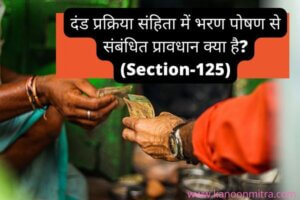धारा 102 भारतीय साक्ष्य अधिनियम – सबूत का भार किस पर होता है —
किसी वाद या कार्यवाही में सबूत का भार उस व्यक्ति पर होता है जो असफल हो जाएगा, यदि दोनों में से किसी भी ओर से कोई भी साक्ष्य न दिया जाए।
दृष्टांत
(क) ख पर उस भूमि के लिए क वाद लाता है जो ख के कब्जे में है और जिसके बारे में क प्राख्यान करता है कि वह ख के पिता ग की विल द्वारा क के लिए दी गई थी।
यदि किसी भी ओर से कोई साक्ष्य नहीं दिया जाए, तो ख इसका हकदार होगा कि वह अपना कब्जा रखे रहे।
अतः सबूत का भार क पर है।
(ख) ख पर एक बंधपत्र मद्धे शोध्य धन के लिए क वाद लाता है।
उस बंधपत्र का निष्पादन स्वीकृत है, किन्तु ख कहता है कि वह कपट द्वारा अभिप्राप्त किया गया था, जिस बात का क प्रत्याख्यान करता है।
यदि दोनों में से किसी भी ओर से कोई साक्ष्य नहीं दिया जाए, तो क सफल होगा, क्योंकि बंधपत्र विवादग्रस्त नहीं है और कपट साबित नहीं किया गया।
अतः सबूत का भार ख पर है।
Section 102 Indian Evidence Act – On whom burden of proof lies —
The burden of proof in a suit or proceeding lies on that person who would fail if no evidence at all were given on either side.
Illustrations
(a) A sues B for land of which B is in possession, and which, as A asserts, was left to A by the Will of C, B’s father.
If no evidence were given on either side, B would be entitled to retain his possession.
Therefore, the burden of proof is on A.
(b) A sues B for money due: on a bond.
The execution of the bond is admitted, but B says that it was obtained by fraud, which A denies.
If no evidence were given on either side, A would succeed, as the bond is not disputed and the fraud is not proved.
Therefore, the burden of proof is on B.
धारा 102 भारतीय साक्ष्य अधिनियम धारा 102 भारतीय साक्ष्य अधिनियम धारा 102 भारतीय साक्ष्य अधिनियम



